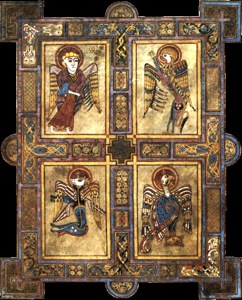 Early Christians liked remote places and in Britain, they spread Christianity into the least populated areas. While Saxon Christians crept up from the south, or came across the North Sea to Northumbria to Lindisfarne Island, others spread Christianity via the Celtic heartlands of Ireland and Scotland. You can’t get more isolated than Iona. The island is to the west of the Isle of Mull, which is part of the Hebrides off the coast of Western Scotland. Given its westerly location, It’s not surprising that it was actually the Irish who arrived in 563AD to found a monastery.
Early Christians liked remote places and in Britain, they spread Christianity into the least populated areas. While Saxon Christians crept up from the south, or came across the North Sea to Northumbria to Lindisfarne Island, others spread Christianity via the Celtic heartlands of Ireland and Scotland. You can’t get more isolated than Iona. The island is to the west of the Isle of Mull, which is part of the Hebrides off the coast of Western Scotland. Given its westerly location, It’s not surprising that it was actually the Irish who arrived in 563AD to found a monastery.
St Columba sailed from Ireland to Iona with twelve companions and built a church and small community. For a while it was quiet and those early monks kept themselves busy. It probably helped take their minds off the weather, which is inclined to be wet and windy. Inside their scriptorium, they created manuscripts. The scriptorium is the ‘place of writing’ and also for illuminating the pages in beautiful inks and decorative gold and silver leaf. By the light of candles, the monks presented depictions of the Gospels or created Book of Hours – a personal book of devotion.

One of the most famous is the Book of Kells, which is on display at Trinity College, Dublin. It’s uncertain where exactly the book was created, however, it is very likely the text was written by the monks of Iona before being taken to the Abbey of Kells in Ireland for illumination. It must have been a labour of love and patience. Only in later monasteries were the monks given added luxuries – the scriptorium relocated next to the warmth of the kitchen instead of being alongside the open cloisters.
The tranquillity of Iona was shattered by the Vikings who arrived in 806 and massacred sixty-eight monks. Those that survived either left for other monasteries, or stayed, but those that did only faced another assault when the Vikings returned demanding to know where the monastery’s treasures were kept. The monks refused to tell them and were killed. Something must have survived at Iona, some kind of church, because in 1203, Raghnall – ‘Lord of the Isles’ supposedly invited Benedictines to establish a monastery and they built it on top of Columba’s original church (This didn’t go down well with the Irish bishops who burnt the first one down.) The monastery persevered. Just to the south of the abbey, the Augustinian Order built a nunnery for up to 400 nuns. The nunnery now lies in ruins.

St Ronan’s Nunnery
Unlike in England where Henry VIII reigned, there was no dissolution of the monasteries, instead, Scotland had its own protestant reformation led by John Knox. The result was pretty much the same – the abbeys and monasteries were abandoned.
In the twentieth Century the abbey was restored. The oldest part of the church is St. Oran’s Chapel, which was built by the Lord of the Isles as a family burial chapel. The rest of the abbey was reconstructed in a simple, solid style and became the home of the Iona Community – an ecumenical group of Christians founded in 1938 and committed to peace and justice through the interpretation of the Gospels – keeping Iona Abbey alive as a centre of learning, just as it was in the Dark Ages.
Iona is also famed as a burial place for kings from across Scotland, Norway and France, including Macbeth and the murdered Duncan. This practice ended in 1098 until more recent times. In 1994 John Smith, the then leader of the Labour Party, died suddenly of a heart attack. He loved to visit Iona and is buried there.
Iona remains an important landmark in the history of Christianity and a place where divisions are put to one side.












Iona – what a remote and desolate spot, but one with an incredible history. I have never been, but would like to visit.
Sophie
Sophie’s Thoughts & Fumbles – Dragon Diaries
LikeLike
Very desolate and remote. I would like to visit too, but I’m not good in boats.
LikeLike
I did know about St Columba coming from Ireland to found the church. What an eventful history it’s had – good to know it’s being put to use now, which I didn’t know. I’m always impressed by the love and craftsmanship that went into creating those manuscripts.
LikeLike
The skill in illuminated manuscripts is amazing, especially as it would be very hard to correct mistakes.
LikeLike
Amazing place I have yet to visit. I’ll admit that the weather and isolation puts me off a bit though. Great post, great pics.
LikeLike
I’m not sure I’d cope with the ferry! It would nice to visit, perhaps one day.
LikeLiked by 1 person
[…] which have seen gone. In Britain and Ireland, monasticism began with the Celts at places like Iona, Kildare and Lindisfarne Island, which are well known for their Christian […]
LikeLike